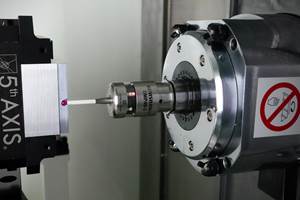Machine Compensation
Ever since electronics first made their way onto machine tools, machine builders and users have tried to achieve some level of "automatic" process control. Certain causes of dimensional variation in machined parts—tool wear, for instance—occur gradually.
Ever since electronics first made their way onto machine tools, machine builders and users have tried to achieve some level of "automatic" process control.
Certain causes of dimensional variation in machined parts—tool wear, for instance—occur gradually. Measuring parts for variation provides a means to efficiently adjust the machine's position settings, to "compensate" for tool wear and other changes.
In the first use of electronics for compensation, parts were gaged by hand, then the operator would press a button on a stepper control attached to the machine tool. One button moved the machine a fixed amount in one direction, while another moved it the same amount in the opposite direction.
The next generation, which integrated electronic gages, took the concept further with automatic feedback control. When the gage sensed that a part had reached or exceeded an approach tolerance, it would send a signal to the machine's controller to compensate. Again, the compensation was a fixed amount each time, and this was known as incremental compensation.
As microprocessors and computers were incorporated into both gaging and machine tools, the simplicity of incremental compensation was replaced by the sophistication of absolute compensation, in which the machine's position is adjusted by the exact amount that is optimum for the process. If desired, compensation can be triggered when part dimensions are drifting just a little bit off nominal, rather than waiting for them to approach tolerance limits.
Computers or microprocessors run algorithms that determine the present level of the process, and look for trends, steps, or other statistical features. While there are a number of different statistical schemes, all use size data from a number of consecutively machined workpieces to establish the current level of the process. A popular, basic scheme is to simply take the average size of the most recent parts. Averaging a large number of parts tends to minimize the influence of normal part-to-part variation, and reduces the number of compensations performed.
Small sample lots, on the other hand, allow the machine to respond faster to process changes.
There are two basic hardware options for modern, automated machine tool compensation. Microprocessor-based CNC/gage interfaces accept input from a variety of electronic gages and gaging amplifiers, and communicate with the CNC via RS232. These are usually panel-mount devices that are pre-programmed to perform a wide range of standard gaging/control actions, with integral keypads that allow users to set approach and tolerance limits, select algorithms, define actions, and so on. The second option is a gaging computer, which offers higher-level capabilities to store or modify algorithms, analyze and utilize data simultaneously from a larger number of inputs, program more complex actions, and store and communicate data. They can be readily interfaced with most modern CNCs and other production equipment.
For example, a large agricultural equipment manufacturer uses a gaging computer to maintain control over gear blank production in fully automated workcells. A robot loads a part into an NC lathe, then removes the half-turned part, turns it around, and loads it into another lathe, which turns the other half. The robot then places the part on an automated gage that measures several ID and OD dimensions. After gaging, the robot stacks the parts on pallets.
All gage functions are controlled by the gaging computer, which allows the manufacturer to switch instantly between eight different part numbers. The computer compensates the lathes based
on the average deviation from the three most recent parts, and shuts down the cell instantly should any dimension fall out of tolerance. The computer also accepts data from temperature sensors in the gage, and performs additional machine compensation for thermal influences.
The use of gages for automatic machine compensation can improve overall quality and productivity, reduce scrap, and minimize manpower requirements. It should be seriously considered for all long-running automated or semi-automated applications where dimensions must be maintained within close tolerances.
Related Content
What Should Machinists Know About In-Machine Probing?
In-machine probing doesn’t reach the power of CMMs but can still be useful for pre- and mid-process control, as well as for “rough screening” of parts.
Read MoreParts and Programs: Setup for Success
Tips for program and work setups that can simplify adjustments and troubleshooting.
Read MoreHow To Calibrate Your Calipers
If you’re interested in calibrating your own digital, dial or Vernier calipers, here are some steps to take to make sure it goes off without a hitch.
Read More4 Ways to Establish Machine Accuracy
Understanding all the things that contribute to a machine’s full potential accuracy will inform what to prioritize when fine-tuning the machine.
Read MoreRead Next
3 Mistakes That Cause CNC Programs to Fail
Despite enhancements to manufacturing technology, there are still issues today that can cause programs to fail. These failures can cause lost time, scrapped parts, damaged machines and even injured operators.
Read MoreThe Cut Scene: The Finer Details of Large-Format Machining
Small details and features can have an outsized impact on large parts, such as Barbco’s collapsible utility drill head.
Read More






















